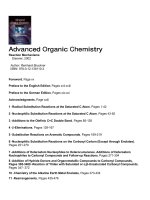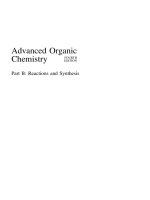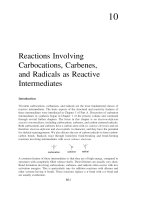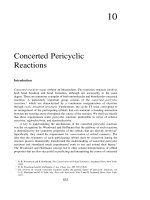Microsoft powerpoint advanced organic chemistry chap 5 兼容模式
Bạn đang xem bản rút gọn của tài liệu. Xem và tải ngay bản đầy đủ của tài liệu tại đây (2.85 MB, 83 trang )
CHAPTER 5
Organometallic
Chemistry
Advanced Organic Chemistry
www.pdfgrip.com
5 1 INTRODUCTION
5-1
I. Organometallic chemistry timeline
1827 Zeise's salt is the first platinum-olefin
complex: K[PtCl3(C2H4)]H2O
1863 C. Friedel & J. Crafts prepare
organochlorosilanes
1890 L. Mond discovers Nickel carbonyl
1899 Introduction of Grignard reaction
1900 P. Sabatier works on hydrogenation
organic compounds with metal catalysts.
Hydrogenation of fats
1909 P. Ehrlich introduces Salvarsan for
the treatment of syphilis, an early arsenic
based organometallic compound.
www.pdfgrip.com
Zeise's salt
Salvarsan
S
l
撒尔佛散
2
•
•
•
•
•
•
•
•
•
1912 Nobel Prize: Victor Grignard and Paul
Sabatier
1930
Henry Gilman works on lithium
cuprates
RX + 2Li RLi + LiX
1951 Ferrocene is discovered
1963 Nobel p
prize for K. Ziegler
g and G. Natta
on Ziegler-Natta catalyst
1965
Discovery of cyclobutadieneiron
tricarbonyl (C4H4)Fe(CO)3
tricarbonyl,
1968 Heck reaction
1973 Nobel prize G. Wilkinson and E. O.
Fischer on sandwich compounds
2005 Nobel prize Y. Chauvin, R. Grubbs, and
R
R.
Schrock on metal
metal-catalyzed
catalyzed alkene
metathesis
2010 Nobel prize Richard F. Heck, Ei-ichi
N i hi Akira
Negishi,
Aki Suzuki.
S
ki "for
"f palladium-catalyzed
ll di
t l
d
cross couplings in organic synthesis"
www.pdfgrip.com
Ferrocene
(C4H4)Fe(CO)3 3
II. DEFINITION
Organometallic compounds (metal organyls, organometallics) are
defined as materials which possess direct, more or less polar
bonds M+— C- between metal and carbon atoms. In addition to
the traditional metals, lanthanides, actinides, and semimetals,
elements such as boron, silicon, arsenic, and selenium are
considered to form organometallic compounds, e.g. organoborane
compounds such as triethylborane (Et3B).
Organometallic chemistry is the study of organometallic compounds.
Since many compounds without such bonds are chemically
similar, an alternative may be compounds containing metalelement bonds of a largely covalent character. Organometallic
chemistry combines aspects of inorganic chemistry and organic
4
chemistry.
www.pdfgrip.com
5
www.pdfgrip.com
Classification of organometallics based on the bond type: -, -, b d
bond:
In evaluations of bond polarity, the electronegativity difference
b t
between
th neighboring
the
i hb i atoms
t
i usually
is
ll employed.
l
d
By way of generalization, it may be stated that the chemistry of
main-group
main
group organometallics is governed by the group the metal
belongs to, whereas for organotransition-metal compounds, the
nature of the ligand dominates. 主族金属有机化合物的化学主要取定
6
于金属本身的性质 而有机过渡金属化合物的性质则主要受其配体支
于金属本身的性质,而有机过渡金属化合物的性质则主要受其配体支
配。
www.pdfgrip.com
7
www.pdfgrip.com
5-2 BASIC CONCEPTS
I. 18-Electron Rule
The 18e rule: characterizing
g and p
predicting
g the stability
y of metal
complexes.
Valence shells of a MT can accommodate 18 electrons: 2 in each of
the five d orbitals (10 in total); 2 in each of the three p orbitals (6 in
total); and 2 in the s orbital.
Combination of these atomic orbitals with ligand orbitals: 9 MOs
which are either metal-ligand bonding or non-bonding. (There are
also some higher energy anti-bonding orbitals). The complete filling
of these nine lowest energy
gy orbitals with electrons,, whether those
electrons originate from the metal or from any ligand, is the basis of
the 18-electron rule.
Thermodynamically stable transition-metal organometallics: the
sum of the metal d electrons plus the electrons of conventionally
g
as being
g supplied
pp
by
y the ligands
g
equals
q
18.
regarded
8
W.B. Jensen. J. Chem. Educ. 2005, 82, 28
www.pdfgrip.com
T bl 1
Table
1. El
Electrons
t
d
donated
t db
by common ffragments
t
Neutral
Positive
Negative
1
0
2
H; X (F, Cl, Br, I); alkyl
2
CH2=CH2, CO, phosphane, etc.
3
2
4
-ally, cyclopropenyl, NO
4
diolefin
6
Cyclobutdiene
4
Ligands
5
6
cyclopentadienyl
6
Arene, triolefin
7
6
Tropylium (C7H7+)
8
10
cyclooctatetraene
www.pdfgrip.com
9
Examples:
p
TiCl4
3s23p63d24s2
Neutral counting: Ti 4e, Cl 1e; 4+4(1) = 8 valence electrons
Ionic counting: Ti4+ 0e, Cl 2e; 0+4(2) = 8 valence electrons
Conclusion: Having only 8e (vs. 18 possible), we can anticipate that
TiCl4 will be a good Lewis acid. Indeed, it reacts (in some cases
violently) with water, alcohols, ethers, amines.
3s23p63d64s2
• Fe(CO)5
Neutral counting: Fe 8e, CO 2e, 8 + 2(5) = 18 valence electrons
Conclusion: This is a special case, all fragments being neutral.
Since this is an 18-electron
18 electron complex,
complex Fe(CO)5 is a stable compound.
compound
• Fe(C5H5)2 , FeCp2
N t l counting:
Neutral
ti
F
Fe 8
8e, C5H5 5e:
5 8 + 2(5) = 18 electrons
l t
Ionic counting: Fe2+ 6e, C5H5 6e: 6 + 2(6) = 18 electrons
Conclusion: Ferrocene is expected to be a stable compound.
compound
www.pdfgrip.com
10
[CpFe(CO)2]2
Neutral counting:
C 5 + Fe 8 + 2 CO 4 + Fe-Fe 1 = 18
Cp
Counting electrons for just one iron center
can be done by considering the other iron
as contributing 1 electron to the count.
CpFe(CH3)(CO)2
Neutral counting:
Cp 5 + Fe 8 + CH3 1 + 2 CO 4 = 18
Fe2(CO)9
Neutral counting:
3 CO 6 + 3 -CO 3 + Fe 8 + Fe-Fe 1 = 18
tri μ-carbonyl bis(tricarbonyliron)(Fe Fe) 11
tri-μ-carbonyl-bis(tricarbonyliron)(Fe-Fe)
www.pdfgrip.com
NOTE:
i. These examples show the methods of electron counting, they are a
formalism,, and don't have anything
y
g to do with real life chemical
transformations. Most of the 'fragments' mentioned above do not
exist as such; they cannot be kept in a bottle. these formalisms
are only used to predict stabilities or properties of compounds!
ii. The 18-electron rule is just that - a rule, not a law. Many MT
complexes
l
d nott follow
do
f ll
thi rule,
this
l and,
d furthermore,
f th
compounds
d
which have fewer than 18 valence electrons tend to show
enhanced reactivity.
reactivity In fact,
fact 18 electrons is often a recipe for
non-reactivity in either a stoichiometric or catalytic sense.
iii. It is especially useful for organometallic complexes of the Cr, Mn,
Fe, and Co triads, and applies to compounds such as ferrocene,
iron pentacarbonyl, chromium carbonyl and nickel carbonyl.
12
www.pdfgrip.com
Violations to the 18-electron rule:
i. Bulky ligands.
Ti(neopentyl)4 (8 VE)
Cp*
C *2Ti(C2H4) (16 VE)
Cp*Cr(CO)3 (17 VE)
Co(norbornyl)
(
y )4 ((11 VE))
C *
Cp*
ii. High spin complexes
CrCl3(THF)3 (15 VE)
3s23p63d54s1
[Mn(H
[M (H2O)6]2+ (17 VE)
[Cu(H2O)6]2+ (21 VE)
iii. Higher electron counts
Cobaltocene (19 VE)
Nicklocene (20 VE)
iv. 'Inaccessible' high energy orbitals
CuCl(CO) (14 VE)
Vaska
Vaska's
s compound: [IrCl(CO)(PPh3)2] (16 VE)
www.pdfgrip.com
N
Norbornane
b
降莰烷
13
II -Backbonding
II.
Backbonding
-Backbonding (-backdonation):
electrons move from an atomic
orbital on one atom to a *
anti-bonding orbital on another
atom or ligand, in the process
relieving the metal of excess
negative
ti charge.
h
Examples:
Ni(CO)4, Zeise
Zeise’s
s salt
FIG.1. Top: the HOMO and LUMO of CO.
Middle: a sigma bonding orbital in which
CO donates electrons to a metals center from its HOMO.
Bottom: the metal center donates electron through a d orbital to CO's
LUMO.
www.pdfgrip.com
14
FIG.2. Orbital overlap scheme for the formation of a -type
i
interaction
i
b
between
an olefin
l fi and
d a transition
ii
metal:
l (a)
( ) overlap
l
off
one lobe of a dx2-y2 orbital from the metal and a -bonding orbital of
the olefin; (b) use of the -antibonding orbital of the olefin.
15
www.pdfgrip.com
III Hapticity 哈普托数
III.
The term hapticity is used to describe how a group of contiguous
atoms of a ligand are coordinated to a central atom.
atom Hapticity of
a ligand is indicated by the Greek character 'eta', η.
ηn: n = the number of contiguous atoms of the ligand that are bound
t the
to
th metal.
t l
The term is usually employed to describe
ligands containing extended
-systems
systems or
where agostic bonding is not obvious from
the formula.
Ferrocene: bis(η
F
bi ( 5-cyclopentadienyl)iron
l
t di
l)i
Zeise’s salt: K[PtCl3(η2-C2H4)].H2O
Uranocene:
bis(η8-1,3,5,7-cyclooctatetraene)uranium
W(CO)3(PPri3)2(η2-H2)
IrCl(CO)[P(C6H5)3]2(η2-O
O2)
www.pdfgrip.com
16
TABLE 2. Electrons donated by "-ligands" vs. hapticity
Ligand
Electrons contributed
(neutral counting)
Electrons contributed
(ionic counting)
η1-Allyl
1
2
η3-Allyl, cyclopropeny
3
4
η3-Allenyl
3
4
η2-Butadiene
2
2
η4-Butadiene
4
4
η1-cyclopentadienyl
1
2
η5-cyclopentadienyl
cyclopentadienyl
cyclohexadienyl
5
6
η2-Benzene
2
2
η6-Benzene
6
6
η7-Cycloheptatrienyl
7
6
η8-Cyclooctatetraenyl
C l
t t t
l
8
10
www.pdfgrip.com
17
Changes in hapticity
The hapticity of a ligand can change in the course of a reaction.
The η5-cyclopentadienyl changes to an η3-cyclopentadienyl, giving
g ligand
g
'L‘. 18
room on the metal for an extra 2-electron donating
www.pdfgrip.com
Hapticity vs.
vs denticity
Polydentate ligands coordinate via multiple coordination sites within
the ligand. Denticity refers to the number of atoms in a single ligand
th t bind
that
bi d to
t a central
t l atom
t
i a coordination
in
di ti complex.
l
Examples:
1,2-bis(diphenylphosphino)ethane,
1 2 bis(diphenylphosphino)ethane (Ph2PCH2CH2PPh2)
dichloro[ethane-1,2-diylbis(diphenylphosphane)-2 P]nickel(II)
titanocene dichloride: (Cp2TiCl2)
dicholorobis(η5-2,4-cyclopentadien-1-yl)titanium
19
Metal-EDTA chelate
www.pdfgrip.com
5 3 IMPORTANT TYPES OF REACTIONS
5-3
I. Oxidative addition/Reductive elimination
In oxidative addition, a metal complex with vacant coordination
sites and a relatively low oxidation state is oxidized by the insertion of
the metal into a covalent bond (X-Y).
(X Y)
Both the formal oxidation state of the metal and the electron count
of the complex
p
increase by
y two.
Oxidative additions can occur with the insertion of a metal into
many different covalent bonds, they are most commonly seen with
HH and Csp3halogen bonds.
Vaska’s Ph3P
OC
complex:
Cl
Ir PPh3
H
H
Ir(I)
VE 16
CN 4
H
H
Ph3P Ir PPh3
OC
Cl
Ir(III) IR:
CO cm1
18
6
Vaska's complex: 20
1967
Vaska's + I2: 2067
www.pdfgrip.com
A reductive elimination involves the elimination or expulsion of a
molecule from a transition metal complex. In the process of this
elimination, the metal center is reduced by two electrons.
The groups being
eliminated must be in a
mutually cis orientation.
A series of reactions
involving an oxidative
addition, a rearrangement
and then a reductive
elimination form the basis
for a variety of industrially
important catalytic cycles.
www.pdfgrip.com
21
II. Transmetalation
Transmetalation is a general chemical reaction type describing the
exchange of ligands between two metal centers. The metal centers
need not be the same. The ligands R and R' can be organic or
inorganic.
Transmetalation is important in the synthesis of various
organometallic compounds. This reaction type also appears frequently
in the catalytic cycle of various metal catalyzed organic reactions.
Negishi coupling:
R
X + R' Zn X'
R
R'
Reductive
Elimination
Eli i ti
PdLn
Pd(0)
R
R
R'
X
Oxidative
addition
R PdII X
R PdII R'
22
X Zn X'
transmetalation R' Zn X'
www.pdfgrip.com
III. Carbometalation
Carbometalation is an reaction involving the nucleophilic addition
to alkenes and alkynes of a diverse range of organometallic reagents
such as organolithium compounds,
compounds organocopper compounds and
Grignard reagents according to the following general alkyne scheme:
tamoxifen
23
www.pdfgrip.com
IV. Migratory insertion
A migratory insertion reaction is when a cisoidal anionic and neutral
ligand on a metal complex couple together to generate a new
coordinated anionic ligand.
ligand This new anionic ligand is composed of
the original neutral and anionic ligands now bonded to one another.
Anionic: H-, R- (alkyl),
Ar-(aryl), acyl-, O2- (oxo)
Neutral: CO, alkenes,
alkynes, carbenes
No change in formal oxidation state (exception: alkylidenes).
The two groups that react must be cisoidal to one another.
A vacant coordination site is generated by the migratory insertion.
Migratory
Mi t
insertions
i
ti
are ffavored
d on more electron-deficient
l t
d fi i t metal
t l 24
centers.
www.pdfgrip.com
Alkene Migratory Insertions.
Alkene and hydride/alkyl migratory insertion is the basis for almost all
transition metal
metal-based
based polymerization catalysts.
catalysts
Coordination
Migratory
insertion
A polymerization
l
i ti
i just
is
j t many, many migratory
i t
i
insertions
ti
off an
alkene and alkyl (the growing polymer chain) interspaced with
alkene ligand addition reactions.
25
www.pdfgrip.com









